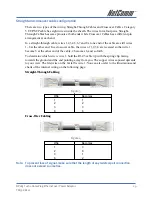
22
NP285 Turbo HomePlug Ethernet over Power Adaptor
YML798 Rev1
6. Frequently Asked Questions
General
What is the HomePlug technology?
HomePlug technology uses your electrical grid, already available inside the walls of
your house or office to transmit data from computer to computer. HomePlug technology
modulates computer data in a way that enables them to use the power grid as a medium
of transmission from point to point. Using this technology, two computers have a virtual
Ethernet connection without the need to be physically connected to each other.
How does HomePlug technology differ from the Internet Power line technology and
why did Internet Power line Technology not become accepted in the market when
HomePlug is available? Is it another technology?
There are two important differences between the technologies, HomePlug and Internet
Power line. With HomePlug the coverage distance is smaller. Internet Power line
technology has to transmit stronger signal levels to cover a longer distance. This caused
different problems, e.g. problems concerning radiation and compatibility with other devices
(electromagnetic compatibility C-Tick/EMR).
Furthermore, with Internet Power line technology the provided bandwidth has to be shared
with up to several hundred members, but with HomePlug, the bandwidth is only shared
amongst a small number of users.
Is HomePlug technology compatible with other home networking technologies
(including phone line, wireless, and structured wiring)?
HomePlug technology does not cause interference to other technologies. In fact, a great deal
of work was done to ensure that the products using HomePlug technology would co-exist
with other methods of home networking.
Because power outlets are located in nearly every wall of a home, they are a logical choice
to use for data connection. Even though some newer homes are built “network-ready” and
pre-wired with Category 5 wiring, they are likely to have rooms or walls without available
connectivity. HomePlug technology also eliminates some of the problems with wireless
networking, allowing access points to be moved to more convenient locations in the home
thus reducing the need for multiple wireless access points and improving coverage.











































